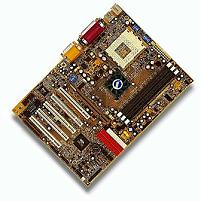The
Layout
The
SL-75DRV2 soldiers on with the already familiar layout of the original SL-75DRV.
Is that a bad thing? Not at all. Again we see that 3 memory sockets are better
than two and allow for a larger possibility of upgrades.  One
of the best design features of the SL-75DRV was its CPU socket and the large unobstructed
area around it. Thankfully the new AthlonXP CPUs run cooler so extremely large
heatsinks aren't the norm with this board but they certainly can fit. Once
again there are four fan power connectors on the motherboard. Two are directly
above the CPU, but one of the other two has been lost since it powers the new
chipset heatsink fan. Not a bad trade since there is still one more available
to the user besides those near the CPU socket. Soltek supports up to 6 USB ports
on this motherboard. You have to purchase a special cable for the other 4 USB
ports and with USB hubs still so inexpensive I think they'd be a better solution.
About the only thing that may be a little odd is Soltek's horizontal IDE slots.
If you have a very large AGP card make sure you install the cable for the floppy
drive first as there will certainly be an interferance problem if you don't.
One
of the best design features of the SL-75DRV was its CPU socket and the large unobstructed
area around it. Thankfully the new AthlonXP CPUs run cooler so extremely large
heatsinks aren't the norm with this board but they certainly can fit. Once
again there are four fan power connectors on the motherboard. Two are directly
above the CPU, but one of the other two has been lost since it powers the new
chipset heatsink fan. Not a bad trade since there is still one more available
to the user besides those near the CPU socket. Soltek supports up to 6 USB ports
on this motherboard. You have to purchase a special cable for the other 4 USB
ports and with USB hubs still so inexpensive I think they'd be a better solution.
About the only thing that may be a little odd is Soltek's horizontal IDE slots.
If you have a very large AGP card make sure you install the cable for the floppy
drive first as there will certainly be an interferance problem if you don't.
A
snip from the oringal review that still applies: "If you look closely you'll
see that there are two jumpers above the CPU socket. These two jumpers allow you
to set the CPU ratio and voltage in 0.075v increments should you coose. What may
be a little harder to see is the third set of jumpers just to the left of the
AGP slot. This jumper set is for setting your FSB. If you are running a 266 MHz
Athlon then you will definately need to adjust this one. Default for this jumper
is 100 MHz but you can choose 110, 120, 133.3, 140, or 150 MHz. But there's even
more for overclockers. Soltek includes a utility that is run from the BIOS setup
area that allows you to set your FSB in 1 MHz increments and also allows CPU voltage
adjustments. More later on my overclocking results. About the only feature I couldn't
find in the BIOS was an option to enable 4 way interleaving for the memory. All
that flexibility in overclocking options is a rarity so I applaud Soltek's commitment
to overclockers." Let's add AGP voltage
adjustment and suddenly there is a very long list of features for overclockers
to enjoy. Also - I discovered that 4-way interleaving can be adjusted in the BIOS
but first you have to set the memory to manual settings and not the automatic
settings for the desired speed. Any huge improvements? No, but it certainly doesn't
hurt to enable every performance improver in the BIOS.
